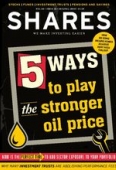Archived article
Please note that tax, investment, pension and ISA rules can change and the information and any views contained in this article may now be inaccurate.
How do some income funds achieve very high yields?

Low interest rates have fired appetite for income from equities and a big proportion of this demand has been satisfied by funds. So how is it that some funds can yield 7% or 8% when the Investment Association Equity Income sector average yield is 4%?
The answer is derivative trading, selling options on some of their holdings, otherwise known as an overlay of ‘covered call options’.
The downside of using this technique is the fund will lose some of its capital growth potential which can impact the fund’s total return.
However, for certain investors, income is the main objective of investing and they will be willing to forego total return as a trade off for receiving a regular pay out.
Toby Gibb, investment director at asset manager Fidelity, says it is a good strategy for investors who are focused on income and not bothered with capital appreciation.
Typically the covered call options are sold to investment banks. The success of this technique is highly reliant on market conditions. When there’s heightened volatility and fluctuating stock prices, a bigger premium strike price can be agreed.
Rupert Rucker, head of income solutions at Schroders says: ‘If the strike price isn’t reached we [the fund] still get our premium but the counterparty doesn’t get any upside’.
The type of company is also important. A counterparty is unlikely to enter into a contract to buy a stock whose share price has barely moved in a year.
Funds that use enhanced equity incomes are not all clones of one another; they often operate in very different ways. Some may have the derivatives strategy working alongside the fund manager to come up with strategies whereas for others that is a completely separate department.
THE FIDELITY PRODUCT
Fidelity Enhanced Income Fund (GB00B87HPZ94) targets a yield of 7% and is managed by Michael Clark with the derivatives strategy handled by David Jehan. The pair work closely together with Clark calling his approach SIRP (Safety of Income at a Reasonable Price).
He looks for high quality companies with simple business models, consistent cash flows and predictably sustainable dividends with plenty of cover. Fidelity’s Gibb says the fund has added insurance giant Prudential (PRU) and airline conglomerate International Consolidated Airlines (IAG) as other big dividend payers such as tobacco stocks ‘have a less clear future’.
THE SCHRODER PRODUCT
Schroder’s Income Maximiser (GB00B0HWJ904) uses options to bolster its income. Schroder’s Rucker says companies are bought when they are cheap and gives recent examples like WPP (WPP) and Provident Financial (PFG) and an older addition Tesco (TSCO). The fund will buy them ‘as long as they’ve got a robust balance sheet and we think they’ll recover’.
Fund research house Square Mile says the managers Nick Kirrage and Kevin Murphy screen the market for stocks that have underperformed the market over the medium term but have interesting valuation metrics. Rucker says he uses enterprise value to net operating profit as a metric to find cheap stocks.
A DIFFERENT OPTION
Gary Potter, fund manager on F&C Multi Manager Navigation Distribution Fund (GB00B23Y3D60), has Schroder’s Enhanced Income Fund among its top holdings and yields 4.9%.
‘Holding the enhanced funds in isolation might not be good. With maximiser products people might think they want the income but they should also want the total return,’ says Potter.
It should be noted that this fund is not an equity income product, falling into the category of multi-asset with a large exposure to fixed income assets.
BMO Asset Management, which runs the F&C fund range after acquiring it in 2014, also offers enhanced equity income exchange-traded funds. These aim to deliver a yield of 3% above their respective indices but at a reduced cost relative to actively managed funds.
These products include BMO Enhanced Income UK Equity (ZWUK), BMO Enhanced Income Euro Equity (ZWEU) and BMO Enhanced Income USA Equity (ZWUS).
While these ETFs are cheaper with an annual fee of around 0.3%, they tend to sell call options indiscriminately on a proportion of an index, typically around 50%. In an actively managed enhanced income fund while a similar proportion of investments will have options sold on them, the stocks in question will usually be carefully selected.
COVERED CALLS EXPLAINED
Covered call options are not as complex as they might sound to some investors. Essentially, a fund manager sells an option, giving the purchaser the right, but not an obligation, to buy a stock from the fund at a pre-determined ‘strike’ price on a specific future date.
For this service, the fund receives a premium regardless of whether the option is exercised or not. So in some respects a covered call option works rather like an insurance policy.
If the stock’s price does not hit the strike price by the time the contract expires the fund keeps the premium, which is distributed to investors as a dividend.
If the strike price is reached the fund still keeps the premium, but it has to pay any additional increase in the stock’s value over and above the strike price to the purchaser.
Important information:
These articles are provided by Shares magazine which is published by AJ Bell Media, a part of AJ Bell. Shares is not written by AJ Bell.
Shares is provided for your general information and use and is not a personal recommendation to invest. It is not intended to be relied upon by you in making or not making any investment decisions. The investments referred to in these articles will not be suitable for all investors. If in doubt please seek appropriate independent financial advice.
Investors acting on the information in these articles do so at their own risk and AJ Bell Media and its staff do not accept liability for losses suffered by investors as a result of their investment decisions.
Issue contents
Big News
- Eurozone relief... but for how long?
- Good week for the markets but setbacks for Reckitt and Clarkson
- Stadium purchase to accelerate TT Electronic’s profits scale
- Online isn’t necessarily the ticket to retail success
- Should shareholders get involved with Capita’s £701m rights issue?
- Fast growth vaping firm Supreme to float on the stock market

 magazine
magazine









